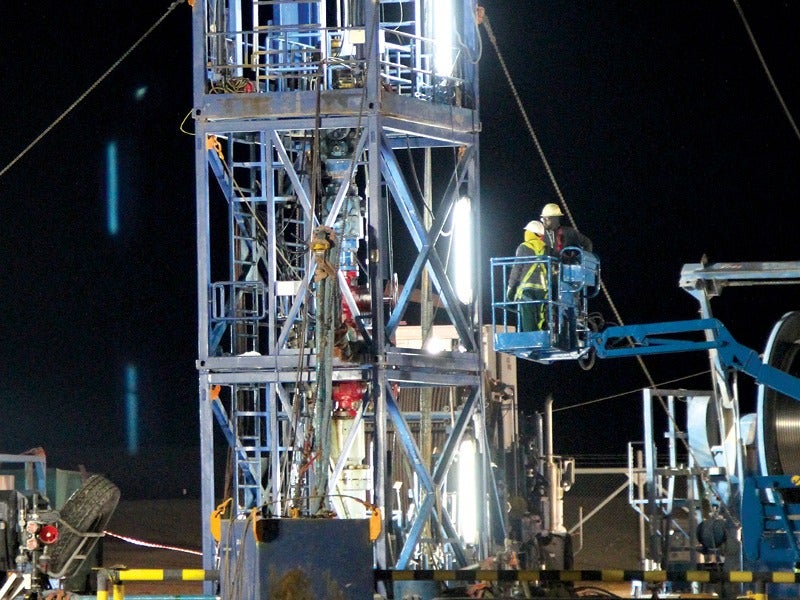The Khurais oil field, located 250km south-west of Dhahran, Saudi Arabia, is the second biggest oil field in Saudi Arabia, after the Ghawar oil field.
The onshore oil field’s production capacity was increased by 300,000 barrels per day (bpd) to 1.5 million barrels per day (Mbpd), as part of the $3bn Khurais Arabian Light Crude Increment Program, which was completed in late-2018.
Owned and operated by Saudi Aramco, the Khurais oil field has been in production since 2009.
The latest expansion project at Khurais involved the development of the lower Fadhli field, installation of new satellite facilities in the Abu Jifan and Mazalij fields, and the construction of the new Oil Train-5 adjacent to the Khurais central processing facility (CPF).
Apart from augmenting the crude processing capacity by 300,000 bpd for Arabian light crude, the expansion project has also increased the gas production capacity by 143 million cubic feet per day (Mcfd) and natural gas liquids production by 34,000bpd.
On 14 September 2019, Saudi Aramco reported a terrorist attack on the Khurais and the Abqaiq oil processing facility resulting in production suspension of 5.7 million barrels of crude oil per day.
Khurais oil field background
Although discovered in the late-1950s, initial project development for the oil field with estimated recoverable oil reserves of more than 25 billion barrels was started in 2006.
At the time of commissioning in 2009, the project included four gas/oil separation units, process utilities, seawater pipelines, and a seawater treatment facility.
The plant’s installed processing capacity was 1.2Mbpd of Arabian light crude, 320Mcfd of associated gas, and 80,000bpd of natural gas liquids.
Spread over 2,890km²2, the Khurais oil project comprises three main fields, namely the Khurais field that covers an area of 1,200km² and the Abu Jifan and Mazalij fields located to the south-west and south-east of Khurais, respectively.
Saudi Aramco initiated the Khurais Arabian Light Crude Increment Program in 2012, as part of its Vision 2030 to make the best use of its proved reserves of 332.9 billion barrels of oil equivalent (bboe), while leveraging the growing demand for energy and the volatile oil market.
The front-end engineering and design (FEED) for the oil field expansion project was completed in 2014. The engineering, procurement and construction (EPC) contract too was awarded in the same year.
Khurais expansion project details
The Khurais Arabian Light Crude Increment Program involved the addition of a new 300,000bpd oil train, a new 257mcf gas train, a gas-oil separation plant (GOSP), and associated pipelines for the Abu Jifan and Mazalij satellite fields.
A 900,000bpd crude storage tank, a 717,000bpd crude oil shipping pump, two gas turbine water injection pumps of 1.06Mbpd combined capacity, and a sulphate removal facility combined with 250,000bpd water injection pumps to support production from the Khurais Lower Fadhili Reservoir have also been installed as part of the project.
Other infrastructure facilities developed as part of the expansion project include a 160MW combined-cycle cogeneration plant, an advanced membrane technology-based seawater reverse osmosis plant, and a 72km-long and 48in-diameter seawater injection pipeline.
Further, a 1.6Mbpd gas-driven booster pump at Ain Dar water injection plant and 243km of oil and gas pipelines were installed.
The oil production wells of the fields were also connected with non-metallic reinforced thermoplastic pipe (RTP) flow lines of a total length of 390km.
Contractors involved
Foster Wheeler was contracted to carry out the front-end engineering and design (FEED) study for the Khurais Arabian Light Crude Increment Program in October 2013.
Snamprogetti, a subsidiary of Saipem, was awarded an engineering, procurement, and construction (EPC) contract worth $2bn for the Khurais oil field expansion, in October 2014.
Baker Hughes, a subsidiary of GE, in collaboration with Saudi Aramco, successfully completed the installation and testing of the TransCoil rigless-deployed electrical submersible pumping (ESP) system for the first time at the Khurais facility, in February 2017.





